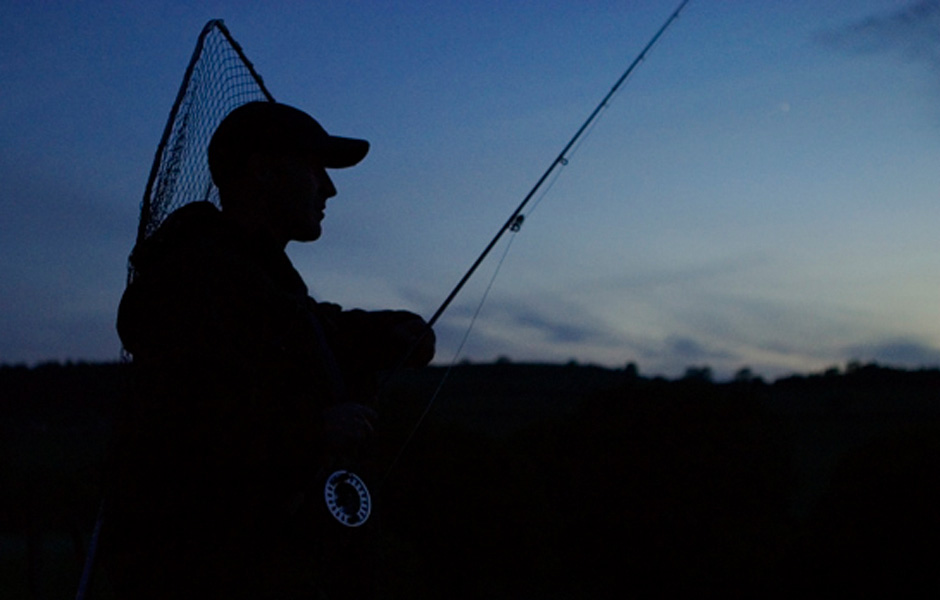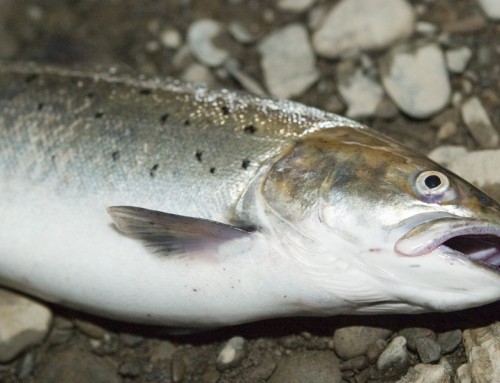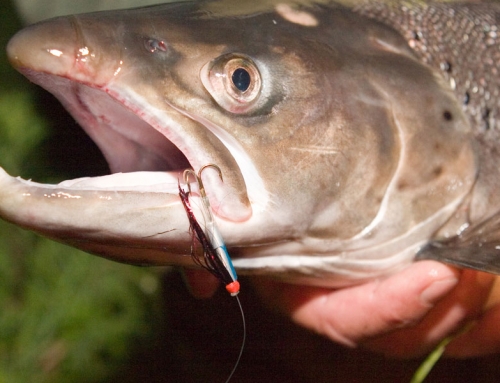Productive sewin rivers are few and far between but local expert Lyn Davies reveals a relatively unknown river in Southwest Wales – the River Loughor.
Being an active committee member of Pontarddulais and District Angling Association (PAA), over the years I have really become to appreciate how lucky I am. Within ten minutes, I can be stood by the banks of the Loughor, waiting patiently for the brownies to stop rising and darkness to fall, knowing that if I catch a sewin, there’s a good chance it’ll be 3lb plus – heaven!
On this occasion, I was fishing alone but being honest I prefer to fish in company. It’s always nice to share a conversation with a mate while you wait for darkness. Also, it’s the comfort factor of knowing someone else is on the river – it helps me concentrate on the job in hand. The Loughor is a very lonely river – it’s not for the faint hearted. I’ve fished on nights so dark that you struggle to see your hand in front of you! On such nights, the slightest unusual noise or movement can make you feel very uncomfortable and spoil a potentially productive session. If I do fish with a mate, we tend to be separated for most of the night. The Loughor is relatively small, so there’s rarely enough space for two angers in one place. Communication via mobile phones is important – not only for safety but to provide live fishing reports throughout the session. If you or your mate latch into a possible fish of a lifetime, having someone else ready with a net can save the day and of course, it’s great to share the experience.
Conditions were ideal. It was cloudy, still, and warm with the chance of a shower – just how I like it. It was a Saturday night in August and as I stood overlooking one of my favourite pools, I paused to think what most ‘normal’ thirty-year-olds would be doing. They would probably be out clubbing; chasing women, looking forward to a curry and staggering home in the early hours of the morning. It’s true, to catch sea trout regularly you must be willing to put the time in – and believe you me, night fishing and romances do not work! In fact, I know a regular on the nearby River Towy who will only consider a relationship during the winter months. Now that’s what I call dedication!
The golden rule of night fishing is to keep things simple. Short leaders, single flies and short accurate casts are the order of the day (or night I should say). Other, larger rivers like the Towy require different tactics but the Loughor is a small, overgrown, and difficult river to fish. It can also be treacherous at times, with its high unsafe corroding banks. As ever, I would advise you walk or better still fish the water during the day prior to a night session.
My preference for a night shift is my ever-faithful 10ft, 8wt Sage RPL, accompanied with a large arbour reel with a good drag. Large arbours have made life a whole lot easier for us night fishers. When a good sewin takes, it’ll thrash about the surface, make a mad initial run, stop, and sometimes run straight back towards you! A reliable responsive reel is vital, and today’s modern reels allow you to keep in contact with such lively fish.
I like my fly to fish quite deep in the water, so I always fish with a Cortland Blue intermediate line – even in the lowest of water. I began to set-up by carefully threading my braided loop through the rod rings. We have all started to cast and realised that something wasn’t quite right – yes, we’ve missed a rod ring… At night, I count every rod ring I thread – I know my Sage has eleven. Time is of the essence at night, and you do not want to be messing around by the water’s edge during the most productive period – that first hour of darkness.
When you are fishing a small spate river you must be prepared to keep on the move so therefore you do not want to lug loads of kit around. The Loughor is full of wonderful nooks and crannies, which provide ample opportunities for anglers to always fish fresh un-fished water. It’s always more productive to cover as much different water as possible.
The same 6ft length of 10lb Maxima remained attached to my braided loop from the night before. I ran the leader through my fingers, checking for any kinks or wind knots and opened my fly box. I’ve tried all types of flies, all shapes and sizes, colours, and weights for sewin. For me, there is only one fly – a Tube Fly. Call me narrow minded but over the years, I have gained such confidence in a small simply dressed aluminium tube that I rarely fish with anything else. Yes, like many fly fisherman, my fly box is stuffed full of various homemade concoctions of fur and feather but nine times out of ten, it’s the tube that goes on the end of my line.
Again, my tube fly dressing is simple. I don’t bother with a body material; the bare aluminium tube works fine – tinsel bodies and ribs only come undone after a few fish. I use fire orange tying thread, a wing of dyed black squirrel tail along with an under hackle of dyed teal blue cock hackle fibres. Many sewin flies include Jungle Cock eyes. I love the look on them, but I don’t think this expensive, delicate material is necessary. I will, however, add a few strands of a flashy material over the top of the wing.
An aluminium tube lands with a little splash, which might attract a fish and of course it sinks quicker than most traditional single hook flies. On a small river, there is a small window of opportunity for a fish to see your fly and take it. Depth is crucial and I believe a tube gets you to the fish with the minimum of fuss. Many locals’ fish with Muddler’s and other traditional single hook flies but it’s all about confidence, and tubes do it for me. I also carry a Surface Lure in my box. As the late Falkus stated, the Surface Lure will only work on some rivers. Fortunately, it does work on the Loughor and it’s always worth a try.
I threaded my line through the small, half-inch tube and attached my size 10, Partridge outpoint treble via a tucked blood knot. Tubes need some sort of rubber sleeve to hold the treble in place and I prefer to use a shrink wrap material. This is the material that you put over a naked flame and it reduces in diameter, creating a stiff hollow tube to attach your treble. The material tends not to slip off the tube – unlike normal softer tubing. When is comes to trebles, I’m fussy and only use Partridge. My only criticism is that they don’t stay pin sharp for long. During an outing, it’s inevitable that you will catch the opposite bank or an overhanging tree – so keep an eye on them. Sea trout can be notoriously difficult to hook, so don’t cut corners in this department.
That’s it, my set up is complete. The next 15mins or so was spent surveying the pool and becoming accustomed to the failing light conditions. Night fly fishermen are a rare breed – a lot of anglers are put off by the darkness – I love it! Limit the use of your torch and you will soon get used to it. It’s surprising how well you can see, even on the darkest of nights. I carry a small torch, but I must admit, I rarely use it but it’s nice to know that you have one to hand in an emergency. Most of my tangles are sorted by holding the bird’s nest up against the night sky.
It was time to start. All my night fishing is done whilst wading, so chest waders are essential – you need to be able to access the most difficult of spots to cover fish. Also, you don’t need to be worried about going over the top of your thigh waders, getting wet and spoiling a night’s fishing. I personally don’t wear expensive waders. Barbed wire, submerged trees and rocks all destroy waders – a pair usually only last me a season or two, so I search for the cheapest models. Wading in the dark is a skill in itself – take nothing for granted, that submerged branch that you are balancing on will give way, so always feel for something solid under your feet. Practice makes perfect, always move carefully and cautiously – I’m never happy unless I’m up to my armpits in water!
Heron like, I edged my way down towards the tail of the pool clinically positioning my tube as close as possible to the opposite bank. Sewin will take as soon as the fly hits the water, so always be prepared for action. Within a few casts I received a sudden ‘bang’ out of the blue, my heart stopped – it was a small brownie. You will catch a fair few brown trout at night on the Loughor. If nothing else, they keep you alert and increase your concentration levels. After a lot of splashing and disturbance, I released the lively half-pounder and checked my tube. It’s essential that you check your fly at regular intervals. Following a fish or any sort of tangle with the opposite bank or underwater weed, make sure your fly is fishing correctly. Tube fly trebles tend to stick out at odd angles, so keep an eye on them. A spot check against the skyline every 10 minutes or so is advised.
By the way, the Loughor is well known for its resident otters, so don’t be too surprised if you see a large mammal snorting, doing backstroke past you! From experience, an otter’s presence doesn’t put the fish down too much, having said that, I’d prefer not see one until I’ve fished through a hot spot!
I fished down through the tail of the pool, but all was quiet – they didn’t seem to want to know. I reeled in and left the river as quietly as I entered. Clambering up the bank, I crossed over a barbed wire fence and headed across a field to another pool, some 200yds up stream.
Usually, only one chance you’ll get at a particular fish, so more places you can cast a fly the better. Always keep on the move, and don’t flog a place. If you’ve felt a fish, give it a few more casts and move on – you’d be better concentrating on that spot an hour or so later.
I knew the next pool held fish, it does so every year, but they always prove difficult to catch. A deep, slow moving back eddy is between you and fish and with a high bank behind, it’s a difficult place to cast. Not many people fish it for this reason, but these are the places that hold fish. You should always give them a try – even if you do loose a fly. It’s not much of a price to pay for a cracking, fresh sewin in the bag. After some awkward casts, and some cursing I found myself in a half decent position to cast a line.
Following a long cast under the overhanging trees on the opposite bank, my tube stopped mid flow – my prayers had been answered. I felt the weight of a nice fish, quite deep – just where I’d expected to see one. When a sewin takes, it will usually come straight to the surface, roll about and splash like mad – this one was no exception. I’ve lost many fish at this point (especially in fast flows), when you try to hold the fish back in a panic. This is a mistake. You must remember to either drop the rod or give the fish line to allow it to turn and perform its first run. Many salmon anglers keep a loop of line, just for this reason. I dropped the rod; the fish found its bearings and shot off, presumably back to its lie under the trees. At this point, you need to instantly consider your location in the water. Can you stay where you are to land the fish, or will it be easier and safer to try and move elsewhere?
I decided to walk slowly backwards out of the water, towards the clear shingle bank. My large arbour soaked up any loose line and I was soon in close contact with the fish. Always be ready for the unexpected. A sewin will run 20yds in no time, in any direction – so check your drag. Make sure it’s not too tight or too loose, a fully loaded reel can easily tangle if the fish makes a mad dash for freedom.
I’ve fished for these fabulous fish since I was twelve years old (I’m now 50), and I still shake like a leaf every time I hook one. It’s by far my favourite form of fly-fishing and the most frustrating!
After a few mad close-range runs, the fish was around my feet and ready to net. I had already released my net and positioned it between my legs, ready for the first opportunity to scoop the fish out of the water. A sewin will splash and roll around in the shallow water towards the end of the fight and this is when they will throw the hook. It’s vital that you intercept them early – you haven’t always got time to wait so see their silver bellies. I caught a glimpse of the whole fish and dragged it over my submerged net. Bingo! A stunning four-pounder filled my net as I walked backwards to a safe, flat area of shingle.
Laying the specimen out flat within the partly submerged net, I admired its beauty for a minute or so. These moments are truly magical. Time seems to stand still as it sinks in that you’re finally being rewarded with such a prize. I had done it. Not only had I caught another fish to remember, more so, I had caught a fish in a place where I usually blank. This, to me is the best part of it all. I now have confidence in another little stretch of the river, which no doubt will produce the goods at another time. I’m a firm believer that if you put the time in, you will reap the rewards – this is especially true with night fishing. Every night you go out, you pick up on new things. You mark a good fish; you notice fish behaviour and get to know when it’s time to go home!
I revived the fish and soon watched it disappear into the darkness of the pool. The thought of work the next day had the better of me and I was ready for the fifteen-minute trek back to the car. I’d come out alone, been at one with nature and out-witted one of the shyest of fishes – the more sewin I catch, the more respect I have for them.





Loved reading this, your passion shines through. I’ve just got my first fly fishing rod, can’t wait to keep practising!
Anna